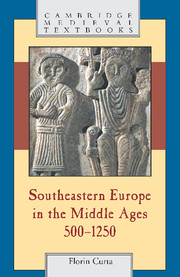Book contents
- Frontmatter
- Contents
- List of maps
- Acknowledgments
- Note on transliteration, names, dates, and words
- Chronology
- List of abbreviations
- Introduction
- 1 The end of Late Antiquity or the beginning of the Middle Ages (c. 500–c. 600)?
- 2 Southeast European “Dark Ages” (c. 600–c. 800)
- 3 The rise of new powers (800–900)
- 4 Iron century or golden age (900–1000)?
- 5 The first Byzantine century (1000–1100)
- 6 The second Byzantine century (1100–1200)
- 7 Between the Crusade and the Mongol invasion (1200–1250)
- 8 Conclusions and lingering questions
- Select Bibliography
- Index
- Cambridge Medieval Textbooks
8 - Conclusions and lingering questions
Published online by Cambridge University Press: 05 June 2012
- Frontmatter
- Contents
- List of maps
- Acknowledgments
- Note on transliteration, names, dates, and words
- Chronology
- List of abbreviations
- Introduction
- 1 The end of Late Antiquity or the beginning of the Middle Ages (c. 500–c. 600)?
- 2 Southeast European “Dark Ages” (c. 600–c. 800)
- 3 The rise of new powers (800–900)
- 4 Iron century or golden age (900–1000)?
- 5 The first Byzantine century (1000–1100)
- 6 The second Byzantine century (1100–1200)
- 7 Between the Crusade and the Mongol invasion (1200–1250)
- 8 Conclusions and lingering questions
- Select Bibliography
- Index
- Cambridge Medieval Textbooks
Summary
The current concerns with the definition and limits of Europe may be traced back to Leopold von Ranke (1795–1886) and his idea that, as an appropriate unit of analysis, Europe was a product of Latin and Germanic peoples. There was no room for the Slavs in the concept of Europe that some of Ranke's contemporaries had in mind, and little understanding for eastern Latin nations, such as the Romanians, or for their non-Latin, non-Germanic, and non-Slavic neighbors – the Hungarians. To Georg W. F. Hegel (1770–1831), Ranke's older contemporary, the Slavs were by no means “an independent element in the series of phases that Reason has assumed in the World.” Excluding the folkloric East from history was a matter of drawing lines of contrast against which the European high culture could be better defined. As one author sagaciously observed, “the invention of Eastern Europe was a subtly self-promoting and sometimes overtly self-congratulatory event in intellectual history, whereby Western Europe also identified itself and affirmed its own precedence.” Hegel and Ranke's formulations were subsequently modified to fit local concerns, but their premise remained unaltered. Early twentieth-century historians in many East European countries reinforced, rather than challenged, that premise. Każimierz Tymieniecki included into Eastern Europe the regions east of the Elbe now in eastern Germany and Poland, but excluded both Scandinavia and the Balkans. He viewed Scandinavia as a part of the “West,” while the Balkans, in his eyes, were not truly European.
- Type
- Chapter
- Information
- Southeastern Europe in the Middle Ages, 500–1250 , pp. 415 - 437Publisher: Cambridge University PressPrint publication year: 2006



